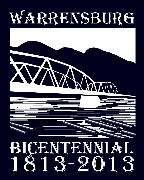Warren House - The tavern originally built by James Pitts in 1789 on Main Street north of Horicon Avenue was sold to Jasper Duell about 1800. In 1804 Duell sold to James Warren, who named it the Warren House. James Warren died in 1811 but his wife Melinda carried on the business. In 1814 a new building was erected, with additions coming in 1838 and again in 1854. It remained in the Warren family until 1866. After 1866, it was sold several times until, in 1878, John Heffron purchased it. Heffron made many repairs and renovations but the building burned in 1888. He sold the property to Alfred Brown, the former proprietor of the Riverside Hotel, in 1891. Plans for a new building to accommodate fifty guests were drawn by H. I. Dwyer of Glens Falls and the hotel opened in late May, 1892, keeping the name Warren House. According to the Warrensburgh News, "The building will be three stories high with a double piazza in front and on the south end. . . . The first floor will be finished in hard wood. On the second floor will be situated the bath rooms, etc. The sleeping apartments on the second and third floors will be commodious and well lighted." After a series of owners (Alfred Brown to Ashley Kellogg to G. C. and G. R. Waters to Maurice O'Connor), it was again destroyed by fire on April 21, 1921. The Warrensburg News reported that the fire was suspicious since a town-owned reel of hose stored at the hotel was found slashed the week before. In addition, the heavy brass nozzle was pounded and so distorted; it could not be attached to the hose.
James Warren and the Site of the Warren House
Opposite the Swan house on the corner of Main Street and Horicorn Avenue once stood the large and famous Warren House. The proprietor, James Warren, was the gentleman for whom the town of Warrensburgh was named. All evidence of this illustrious hotel is gone. It was destroyed by fire during the winter of 1888-89, rebuilt in 1892, destroyed by fire, again, in 1921. After the second fire the area was gradually built up with other smaller and varied businesses.
Reference to James Warren and the Warren House provides an opportunity to review the history of Warrensburgh and its origin, beginning with the time when the first know settler, William Bond, set foot on local soil.
The town of Warrenburgh was forme3d form the old town of Thurman on the 12th day of February, 1813. The Warrensburgh Tract was patented by the State of New York and sub-divided for the purpose of paying off Revolutionary War Soldiers.
The earliest known settler, William Bond, came to the United States from England in 1760, and, in 1786, moved to a tract of land two miles southwest from the site of the village of Warrensburgh. Bond's Pond (Echo Lake) was named for him. His deed, dated 1784, indicated that Bond paid 325 pounds for a tract of 7,500 acres. Records make no mention of him as he died before the present town was formed.
The county of Warren was named for the Revolutionary War hero, General Joseph Warren. The town of Warrensburgh was named for James Warren, who arrived here in 1804. Warren purchased a farm from John Thurman upon which stood Pitts Taver, the original public house antedating the Warren House. James Warren kept the first store in town, built and conducted an extensive potash factory on the north side of the Schroon River.
In the early days, elections were held at different parts of town on three consecutive days, it being impossible to establish a central pint enabling all voting population to cast their vote and return home the same day. In 1811, James Warren, returning from elections hald on a farm in Thurman, was drowned by the upsetting of a skiff in the West River (Hudson River). His son, Nelson (age 10), was with him at the time and the harrowing experience reputedly turned the boy's hair white. Two years after his fatality, the town of Warrensburgh was organized and names for him. On April 4, 1813, the first town meeting was conducted by the widow of James Warren in the Warren House. It was the Warren House, also, tha housed the first post office in town, established in 1806, by Kitchell Bishop.













